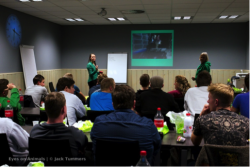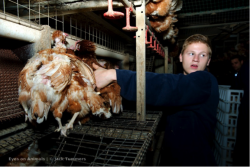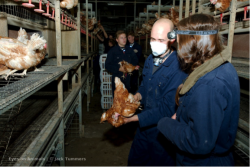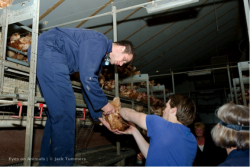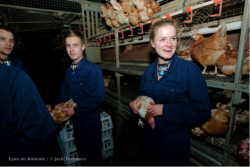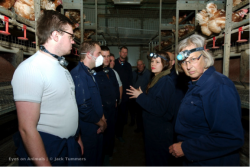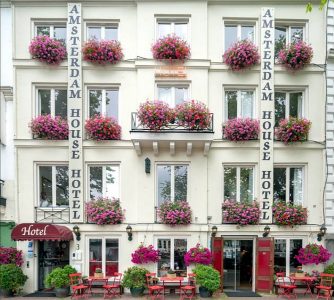Last Thursday (October 27th 2016) Eyes on Animals – with support of the Dierenbescherming – presented an animal welfare course to 24 bird catchers of Van den Broek. Van den Broek is one of the largest poultry companies in the Netherlands and we encounter them regularly during our inspections. Van den Broek responded positively to our request to attend a course and as many as 24 catchers (23 men and one woman) have joined the course. A member of the NVWA was also present to observe the course.
The course consisted of an interactive presentation and a visit to a poultry farm to catch and load chickens the EonA Dutch way. Normally, chickens are grabbed by their legs (3-5 per hand) and then stuffed headfirst into transport crates. With the EonA Dutch method, the chickens are picked up a maximum of two at a time, in an upright position with support under their chest and then placed upright and calmly into the transport crates. The birds suffer a lot less stress and pain this way.
The presentation went very well. Firstly, we discussed the behavior, the anatomy and the physiology of hens and how this information can be used to reduce the suffering of chickens. After that we discussed – on the basis of inspection images – where the catching and loading of hens can be improved. The catchers were very motivated, they asked a lot of questions, made critical remarks and made several suggestions, for example to improve the design of the crates.
For the practical part (EonA Dutch catching method) we went to a poultry farm in Nijkerk. Here Van den Broek had 19,000 chickens to catch and load that night. The first consignment of chickens were caught in the EonA Dutch way. Catchers and team managers were very impressed by the calmness in the barn. During the regular catching you hear the occasional cackle. However, it proved difficult to grab the chickens at the back of the racks in the EonA Dutch way. There was not enough space to keep them upright. In consultation with the catchers a new catching method has been used: with one hand the chicken is held by two legs and with the other hand the chicken is raised under the breast. The chickens leaned in your hand so you could gently get them from under the backs of the racks without hurting them or pulling their legs.
During the practical part of the course the operator of the chickens was there as well. He was positive about the catching method and was trying to figure out how much less injury there is to the chickens we had caught in the EonA Dutch way relative to the chickens that were caught in the regular way later that same evening. Wageningen University has already done research on the EonA Dutch trapping method for broilers. This revealed that the EonA Dutch trapping method is less harmful than the regular trapping method or the capture machine.
We would like to thank the catchers, Van den Broek teamleaders and management for their motivation and the interest they took in the course. We also want to thank the farmer Henk Van Hierden and his wife for welcoming us to their business. Finally we want to thank the NVWA for their presence and interest in our course.
Our goal is that the EonA Dutch catching method will become the standard for organic, Demeter and Rondeel chickens. Promising steps have been taken previously. In January 2017 Rondeel will catch their first stall the EonA Dutch way and one of the catching teams we trained will be there to help. The Dierenbescherming is considering taking on the EonA Dutch catching method in the next update of their Better Life Three Star criteria. They have also support this course financially, for this we are very grateful.
To learn more about the difference between the regular and EonA Dutch you can watch this short video.
